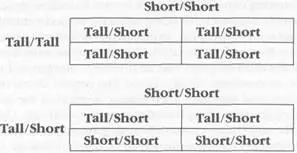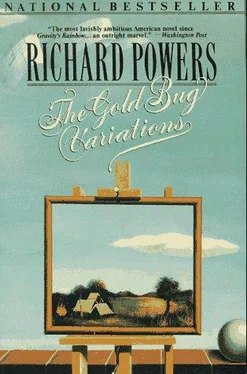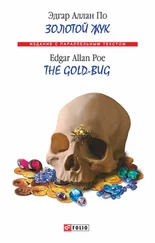Richard Powers - Gold Bug Variations
Здесь есть возможность читать онлайн «Richard Powers - Gold Bug Variations» весь текст электронной книги совершенно бесплатно (целиком полную версию без сокращений). В некоторых случаях можно слушать аудио, скачать через торрент в формате fb2 и присутствует краткое содержание. Год выпуска: 1991, Издательство: Harper Perennial, Жанр: Современная проза, на английском языке. Описание произведения, (предисловие) а так же отзывы посетителей доступны на портале библиотеки ЛибКат.
- Название:Gold Bug Variations
- Автор:
- Издательство:Harper Perennial
- Жанр:
- Год:1991
- ISBN:нет данных
- Рейтинг книги:5 / 5. Голосов: 1
-
Избранное:Добавить в избранное
- Отзывы:
-
Ваша оценка:
- 100
- 1
- 2
- 3
- 4
- 5
Gold Bug Variations: краткое содержание, описание и аннотация
Предлагаем к чтению аннотацию, описание, краткое содержание или предисловие (зависит от того, что написал сам автор книги «Gold Bug Variations»). Если вы не нашли необходимую информацию о книге — напишите в комментариях, мы постараемся отыскать её.
Gold Bug Variations — читать онлайн бесплатно полную книгу (весь текст) целиком
Ниже представлен текст книги, разбитый по страницам. Система сохранения места последней прочитанной страницы, позволяет с удобством читать онлайн бесплатно книгу «Gold Bug Variations», без необходимости каждый раз заново искать на чём Вы остановились. Поставьте закладку, и сможете в любой момент перейти на страницу, на которой закончили чтение.
Интервал:
Закладка:
In the span of ten years, Darwin published Origin of Species, Mendel produced his inheritance paper, and Miescher discovered DNA. But it took a century to braid these three. Mendel's undeniable demonstration lay forgotten for thirty-five years, delayed by something dark and surreptitious. The monk's first giant step toward proving Darwin at the mechanical level was another human takedown, this time reducing us from monkey to molecule. Darwin was instant controversy; why total oblivion for the monk? Because of the revulsion produced by mentioning the fecundity of biology in the same breath as inert mathematics.
In Mendel, every characteristic derives from discreet, inheritable factors — his law of segregation, the philosophical implication lost on me until this minute. Seven years' labor in the garden overthrew Aristotle's notion of blended inheritance. Offspring of blond and brunette are not simply sandy. Rather, pairs of independent commands from each parent remain separate in the offspring, passing unchanged to grandchildren. Wildly counterintuitive: all immeasurable diversity deriving from rigid, paired packets. This Augustinian's God was more grossly architectural than the Deists'. For each indivisible characteristic we inherit two paired factors, with an equal chance of getting either half of each parent's paired set. The tune accompanying inheritance's barn dance is aleatoric, more Cage than Brahms. Individuality lies in the die's toss. The language of life is luck.
Mendel rescues living variety by noting that each gene comes in more than one tune. Some alleles for any trait dominate others. The visible result of a gene pair shows only part of the underwriting package. A person's genotype, the internal packet, is not fully revealed by phenotype, the outward form. Blond may lie hidden for generations, erupting again in unknown great-granddaughters.
I picture Dr. Ressler in his first weeks in the lab, wondering about the delicately turned nose of the woman who will nonchalantly waste him. The allele giving her bridge that innocent flip floated detached in either or both her parents. Her Myrna Loy allele might hide a matched half that codes for Irish pug: a half-breed, heterozygous. Or she might need identical alleles from each parent to achieve that cycloid dip — homozygous for profile. The same holds for the hazel eyes. The woman's daughter — I picture him wondering if she has one — might revert to any number of recessive traits: square nose, eyes drab brown. Yet even so prosaic a child could go through life a secret carrier of mother's mystery.
Mendel's Law of Segregation, not to be confused with the Little Rock affair, is itself a shade un-American. You can't tell by looking at a thing what ticks underneath. Two pea plants, both tall in phenotype, might have different genotypes — one homozygous tall and the other heterozygous. Violation of truth in advertising. The language of life is not only laced with luck. It also refuses to say just what it means. The generation of geneticists who rediscovered Mendel devised a way to determine a plant's hidden makeup. If tall allele is dominant over short, then a tall plant might be either Tall/Tall or Tall/Short. Crossbreeding against a known homozygous recessive produces four possible first filials:

Descendants of the homozygous plant all appear tall, while half of the heterozygous descendants will be short. The test cross. Ressler referred to his abandoned profession by a name both sardonic and nostalgic — the irony of one no longer in the inner circle. To Frank and me, he always called geneticists soldiers of the cross.
First filial generation after Mendel had to find where these abstract inheritance packets resided. From the beginning, men hoped that genes would prove chemical, tangible. The coordinated effort reads like the greatest whodunit ever written. Blundering with desire toward fruition, as poet-scientist Goethe says. While geneticists made their gross observations, cytologists began to elucidate the microscopic ecosystem of the cell. As early as mid-nineteenth century, researchers described dark threads in the cell nucleus. Improvements in staining and microscopy revealed that the rods came in mixed doubles. During the choreography of cell division, these chromosome pairs split and moved toward opposite poles. Each daughter cell wound up with a full chromosome complement. Chromosome behavior suspiciously resembled Mendel's combining and separating pairs.
The gene factor somehow lay inside the chromosome, a segment of the thread: a tie bordering on magic. It must have been pure fear, to isolate the physical chunk embodying the ethereal plan, the seed distilling the idea of organism. The first link in the chain from Word to flesh, philosopher's stone, talisman, elixir, incantation, the old myth of knowledge incorporated in things. I can't imagine the excitement of living at the moment when the pieces began to fall into place: living design located in matter. On second thought, I can imagine. This morning's papers carried another update.
Traits didn't behave as cleanly as theory would have them. Morgan and team spent seventeen years in massive, spirit-breaking effort, counting two thousand gene factors in endless generations of Drosophila. Mendel's predicted ratios for second-generation dihybrids did not always occur. Experiment, recalcitrant, gave different numbers than pattern dictated. First temptation must have been to squash the aberrant gnats, take no prisoners. Morgan, not yet believing the chromosome theory, found that certain characteristics always occurred together. Such linkage supported the notion that groups of genes lay along shared chromosome threads. Linked traits lay on the same thread, passed through generations as a unit.
But Morgan's team also turned up incomplete linkage. Occasionally in the chaos of meiosis, paired chromosomes from separate parents cross over, break at equivalent points, and exchange parts. Half a linked group might thus be sent packing. Leverage into the unobservable: the odds of linked traits being split must vary with their distance on the chromosome. The chance of a break falling between two adjacent genes is very small, whereas any split in the chromosome separates the genes at opposite ends of a thread. Frequencies of separation thus mapped relative distance between genes.
The chemistry was still lacking. But chemistry would come. Ressler himself would join in the cartographic project of ever-improving scale. Inexorable, but full of halting dead ends, overlooked insights, reversals. Morgan's work too was resisted by the scientific community, while Levene's incorrect tetranucleotide hypothesis was embraced disastrously for years. Researchers have made every possible mistake along the way. Reject the Moravian monk; doubt Morgan; ignore Avery's 1944 identification of the genetic substance. Fits and starts, endless backtracking, limited less by technique than by the ability to conceive. How do you get moonlight into a chamber? Dress someone up as the moon.
Mendel's laws have since become more complex. Linkage, multiple alleles, epistasis, collaboration, and modifiers enhance his metaphor. But by the time Ressler took orders, neo-Mendelism was forever in place. Cyfer had inherited the idea that all of an organism's characteristics were written in a somatic language, generated by a grammar that produced outward sentences distinct but derivable from deep structure.
I live at the moment of synthesis, sense the work that is almost written, watch the structure complete its span, register for the first time how strewn with mistake and hope the path has been. This place, this night, a lamp, a typing machine, my books, my chromosomal map: I grope for my technique, my leverage into Dr. Ressler's world. The test cross that will spring the hidden, recessive gene. How he blundered with desire toward fruition. How in fruition, pining for desire.
Читать дальшеИнтервал:
Закладка:
Похожие книги на «Gold Bug Variations»
Представляем Вашему вниманию похожие книги на «Gold Bug Variations» списком для выбора. Мы отобрали схожую по названию и смыслу литературу в надежде предоставить читателям больше вариантов отыскать новые, интересные, ещё непрочитанные произведения.
Обсуждение, отзывы о книге «Gold Bug Variations» и просто собственные мнения читателей. Оставьте ваши комментарии, напишите, что Вы думаете о произведении, его смысле или главных героях. Укажите что конкретно понравилось, а что нет, и почему Вы так считаете.












